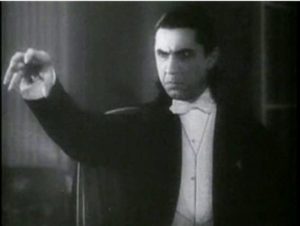64. Dracula, Part 1
In 1897 Bram Stoker wrote his novel Dracula and, in doing so, set the archetype for the modern vampire. Vampire legends had been around since at least the ancient world[1] and the term ‘vampire’ was in circulation since at least the early 1700s. Moreover, there were a variety of popular vampire novels available in the 1800s.[2] But Stoker’s vision introduced a set of characteristics that have been taken up again and again, sometimes with interesting transformations, and which continue to fascinate people of many ages and backgrounds. Since Halloween is quickly approaching, I figured I would provide some information that will help you see that Dracula, far from being simply entertainment, can lead to some important insights. If you haven’t read Stoker’s novel, you can do so at: http://www.gutenberg.org/ebooks/345
Let’s begin by noting some characteristics Stoker attributes to Dracula:[3]
- He is potentially immortal
- He lives off the blood of humans
- He has the strength of 20 men
- He can assume a variety of shapes (e.g., a wolf, bat, mist, or elemental dust)
- He has no reflection in mirrors
- He casts no shadow
- He can hypnotize victims
- He has the power to turn his victims into vampires
- He may not enter a house unless he is invited in
- He loses strength when exposed to sunlight
- He must sleep on soil from his native land
- He is repelled by garlic and Christian symbols (e.g., Eucharist wafer, crucifix)
- He can only be destroyed by driving a stake through his heart and then decapitating him
All of these traits can be read symbolically and one can emphasize one or some over others. It is fascinating to see how they have been interpreted thus far. In this blog I will consider the psychoanalytic approach; in the next few blogs we will look at other approaches.
The psychoanalytic approach typically reads the above traits as symbolic of unconscious drives, fears, wishes, and defense mechanisms. For example, we long to live forever and this wish, born out of a fear of dying, is an unconscious desire that exerts tremendous influence. Dracula offers us immortal life and thus our attraction to him, despite our acceptance that he is not real, is explained by this unconscious desire. However, we are also repulsed since we sense his immortality can only be purchased at the expense of our current human experience. Do we really want to live on forever as one of the undead? Perhaps the limits of our mortal life are precisely what allow the passage of time to have both meaning and drama; without these limits time would become meaningless and boring. But such limits spell our inevitable doom. Such ambivalence makes for fascinating horror.[4]
Under this psychoanalytic heading we could interpret blood sucking as symbolic of sexual urges and fears. We may want to be a sexual predator like Dracula who lives in the shadows outside the social structure with all its marriage, commitment, and obligation. Or we may want to be a victim dragged away from this oppressive order by a force outside our control. Indeed, it must be remembered that Dracula can only enter a dwelling if someone willingly allows him in. And hypnosis is most effective when someone wants to be hypnotized. So the notion that Dracula is the evil one and his victims are innocent seems problematic. In any case, the desire to be a predator can also be read as a sublimation of a sadistic urge to reduce humans to things and the desire to be a victim can be read as a masochistic urge to have oneself treated as a thing. So many of the novel’s events can be read as aesthetic sublimations of sadistic and masochistic drives to harm others and ourselves—urges that are often not very far from sexual ones.
We could also see Dracula’s hunters as symbols of social repression—the kind of repression that gives rise to demonic activity in the first place. Given this perspective, we can ask: Is Professor Van Helsing, Dracula’s main hunter, a dogmatic tyrant who has no tolerance for people who don’t fit into the virtuous mold of his religion? Are vampires romantic victims? Are they symbols for those who are the “other”, those who are different from us that threaten our so-called borders and our so-called identity? Are they demons who seek to feed off the so-called virtuous precisely because the virtuous have made them into demons?
Go here for part two…
[1] For a helpful overview of some ancient sources, see the following interesting article: http://jungian.info/library.cfm?idsLibrary=9
[2] For example, Polidori’s The Vampyre (1819), Rymer’s Varney the Vampire (1845-7) and Le Fanu’s Carmilla (1872).
[3] The following set of traits is from a set compiled by Dr. Elizabeth Miller and can be found on her highly informative website: http://www.ucs.mun.ca/~emiller/bram_vampires_drac.html
[4] For a psychological reading that revolves around the fear of death, see “Dracula and the Afterlife: A Psychological Explanation” by Jack D. Maser in Journal of Dracula Studies Number 7, 2005 http://www.blooferland.com/drc/index.php?title=Journal_of_Dracula_Studies

